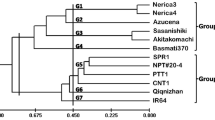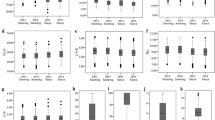Abstract
Hybrid rice has contributed significantly to the dramatic increase of rice production in the world. Despite this, little attention has been given to studying the genetic basis of heterosis in rice. In this paper, we report a diallel analysis of heterosis using two classes of molecular markers: restriction fragment length polymorphisms, (RFLPs) and microsatellites. Eight lines, which represent a significant portion of hybrid rice germ plasm, were crossed in all possible pairs, and the F1s were evaluated for yield and yield component traits in a replicated field trial. The parental lines were surveyed for polymorphisms with 117 RFLP probes and ten microsatellites, resulting in a total of 76 polymorphic markers well-spaced in the rice RFLP map. The results indicated that high level heterosis is common among these crosses: more than 100% midparent and 40% better-parent heterosis were observed in many F1s, including some crosses between maintainer lines. Heterosis was found to be much higher for yield than for yield component traits, which fits a multiplicative model almost perfectly. Between 16 and 30 marker loci (positive markers) detected highly significant effects on yield or its component traits. Heterozygosity was significantly correlated with several attributes of performance and heterosis. Correlations based on positive markers (specific heterozygosity) were large for midparent heterosis of yield and seeds/panicle and also for F1 kernel weight. These large correlations may have practical utility for predicting heterosis.
Similar content being viewed by others
References
Akkaya MS, Bhagwat AA, Cregan PB (1992) Length polymorphisms of simple sequence repeat DNA in soybean. Genetics 132:1131–1139
Crow JF (1952) Dominance and overdominance. In Gowen JW (ed) Heterosis. Iowa State College Press, Ames, pp 282–297
Dietrich W, Katz H, Lincoln SE, Shin HS, Friedman J, Dracopoli NC, Lander ES (1992) A genetic map of the mouse suitable for typing interspecific crosses. Genetics 131:423–477
Dudley JW, Saghai Maroof MA, Rufener GK (1991) Molecular markers and grouping of parents in maize breeding programs. Crop Sci 31:718–723
Dudley JW, Saghai Maroof MA, Rufener GK (1992) Molecular marker information and selection of parents in corn breeding programs. Crop Sci 32:301–304
Duncan DB (1955) Multiple range and multiple F tests. Biometrics 11:1–42
Grafius JE (1961) The complex trait as a geometric construct. Heredity 16:225–228
Immer FR (1941) Relation between yielding ability and homozygosis in barley crosses. J Am Soc Agron 33:200–206
Keim P, Diers BW, Olson TC, Shoemaker RC (1990) RFLP mapping in soybean: association between marker loci and variation in quantitative traits. Genetics 126:735–742
Lin S, Ming S (1991) Rice varieties and their genealogy in China. Shanghai Science and Technology Press, Shanghai (in Chinese)
Liu A, Zhang Q, Li H (1992) Location of a gene for wide compatibility in the RFLP linkage map. Rice Genet Newsl 9:134–136
McCouch SR, Kush, GS, Tanksley SD (1990) Tagging genes for disease and insect resistance via linkage to RFLP markers. In: IRRI (ed) Rice genetics II. (Proc 2nd Int Rice Genet Symp. Manila, Philippines, pp 443–449
Minvielle F (1987) Dominance is not necessary for heterosis: a two-locus model. Genet Res 49:245–247
Morgante M, Olivieri AM (1993) PCR-amplified microsatellites as markers in plant genetics. Plant J 3:175–182
O'Brien SJ (1992) Genetic maps. Book 6: plants. Cold Spring Harbor Laboratory Press, Cold Spring Harbor, N.Y.
Paterson AH, De Verna JW, Lanini B, Tanksley SD (1991) Fine mapping of quantitative trait loci using selected overlapping recombinant chromosomes in an interspecies cross of tomato. Genetics 124:735–742
Rice research group of Mian Yang Agricultural Institute of Sichuan Province (1978) An analysis on heterosis of F1 hybrids in rice. Acta Sin Genet 5:158–164
Saghai Maroof MA, Soliman KM, Jorgensen RA, Allard RW (1984) Ribosomal DNA spacer-length polymorphisms in barley: Mendelian inheritance, chromosomal location, and population dynamics. Proc Natl Acad Sci USA 81:8014–8018
Saghai Maroof MA, Zhang Q, Biyashev RM (1994) Molecular marker analysis of powdery mildew resistance using a barley diallel cross. Theor Appl Genet (in press)
Schnell FW, Cockerham CC (1992) Multiplicative vs. arbitrary gene action in heterosis. Genetics 131:461–469
Smith OS, Smith JSC, Bowen SL, Tenborg RA, Wall SJ (1990) Similarities among a group of elite maize inbreds as measured by pedigree, F1 grain yield, grain yield heterosis and RFLPs. Theor Appl Genet 80:833–840
Sokal R, Sneath PHA (1963) Principles of numerical taxonomy. Freeman WH and Company, San Francisco and London
Song KM, Osborn TC, William PH (1988) Brassica taxonomy based on nuclear restriction fragment length polymorphisms (RFLPs) Theor Appl Genet 79:497–506
Steel RGD, Torrie JH (1980) Principles and procedures of statistics. McGraw-Hill Book Co
Stuber CW, Lincoln SE, Wolff DW, Helentjaris T, Lander ES (1992) Identification of genetic factors contributing to heterosis in a hybrid from elite maize inbred lines using molecular markers. Genetics 132:823–839
Tanksley S, Causse M, Fulton T, Ahn N, Wang Z, Wu K, Xiao J, Yu Z, Second G, McCouch S (1992) A high density molecular map of the rice genome. Rice Genet Newsl 9:111–115
Tautz D (1989) Hypervariability of simple sequences as a general source of polymorphic DNA markers. Nucleic Acids Res 17:6463–6471
Virmani SS, Aquino RC, Khush GS (1982) Heterosis breeding in rice. Theor Appl Genet 63:373–380
Wang ZY, Second G, Tanksley SD (1992) Polymorphism and phylogenetic relationship among species in the genus Oryza as determined by analysis of nuclear RFLPs. Theor Appl Genet 83:565–581
Ward JH (1963) Hierarchical grouping to optimize an objective function. J Am Stat Assoc 58:236–244
Weber JL, May PE (1989) Abundant class of human DNA polymorphisms which can be typed using the polymerase chain reaction. Am J Hum Genet 44:388–396
Weissenbach J, Gyapay G, Dip C, Virgnal A, Morissette J, Millasseau P, Vaysseix G, Lathrop M (1992) A second-generation linkage map of the human genome. Nature 359:794–801
Wright S (1992) The effects of inbreeding and cross breeding on guinea pigs. III. Crosses between highly inbred families. Tech Bull US Dept Agric 1121
Wu KS, Tanksley SD (1993) Abundance, polymorphism and genetic mapping of microsatellites in rice. Mol Gen Genet 241:225–235
Young JB, Virmani SS (1990) Heterosis in rice over environments. Euphytica 51:87–93
Yu YG, Saghai Maroof MA, Buss GR, Maughan PJ, Tolin SA (1993) RFLP and microsatellite mapping of a gene for soybean mosaic virus resistance. Phytopathology 84:60–64
Yuan LP (1992) Development and prospects of hybrid rice breeding. In: You C, Chen ZL (eds) Agricultural biotechnology. (Proc Asia-Pacific Conf Agric Biotechnol). China Science and Technol Press, Beijing, pp 97–105
Zhang Q, Saghai Maroof MA, Lu TY, Shen BZ (1992) Genetic diversity and differentiation of indica and japonica rice detected by RFLP analysis. Theor Appl Genet 83:495–499
Zhang Q, Saghai Maroof MA, Kleinhofs A (1993) Comparative diversity analysis of RFLPs and isozymes within and among populations of Hordeum vulgare ssp. spontaneum. Genetics 134:909–916
Zhao X, Kochert G (1993) Phylogenetic distribution and genetic mapping of a (GGC)n microsatellite from rice (Oryza sativa L.). Plant Mol Biol 21:607–614
Author information
Authors and Affiliations
Additional information
Communicated by P. M. A. Tigerstedt
Rights and permissions
About this article
Cite this article
Zhang, Q., Gao, Y.J., Yang, S.H. et al. A diallel analysis of heterosis in elite hybrid rice based on RFLPs and microsatellites. Theoret. Appl. Genetics 89, 185–192 (1994). https://doi.org/10.1007/BF00225139
Received:
Accepted:
Issue Date:
DOI: https://doi.org/10.1007/BF00225139




